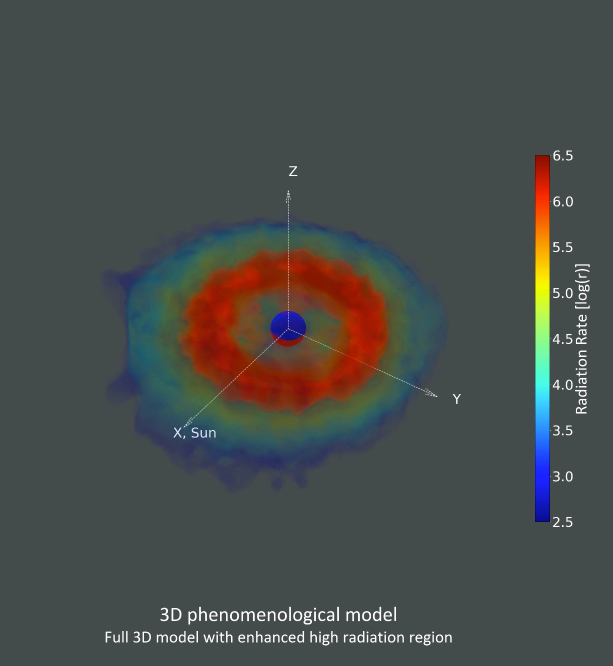
 Credit: Lionel Metrailler, INTEGRAL Science Operation Centre (ISOC), ESAC, Madrid, Spain
Credit: Lionel Metrailler, INTEGRAL Science Operation Centre (ISOC), ESAC, Madrid, Spain
Unbuckling the Van Allen Belts
Interplanetary travelers face a fair number of dangers on their cosmic journey. Belts of deadly charged particles which surround earth are a danger that is particularly close to home. These regions, extending from 500 to nearly 60,000 kilometers above the earth, are called the Van Allen Belts, in honor of James Van Allen, who was crucial to their discovery. The Van Allen Belts are produced when charged particles (electrons and protons and others) ejected by the Sun become trapped by the earth's magnetic field. Knowing the extent of these belts, and how they wax and wane, is important not only for interplanetary travelers but also for communication and other types of satellites in orbit around earth, as well as the astrononauts and instruments on the International Space Station. Important measurements of the Van Allen Belts were done initially by the Explorer 1 and Explorer 3 spacecraft, which confirmed the existence of the Belts, then more recently studied by NASA's Van Allen Probes. Other spacecraft have made important observations of the Belts too. The INTEGRAL gamma ray observatory usually spends most of its time making important observations of high energy phenomena associated with black holes, neutron stars, and other strange objects beyond the solar system. But it also carries a detector that measures charged particles that hit the spacecraft, and its wide orbit carries it through the Belts every orbit. Since INTEGRAL was launched in 2002, it has now more than 15 years worth of in-place measurements of the charged particle population in the Belts. The INTEGRAL team has used these data to create an actual 3-D model of the Van Allen Belts. The image above, with earth at the origin of the coordinate system, shows the intense inner belt in red and the outer belt beyond. The inner belt is mostly composed of protons, while the outer belt is mostly electrons. Other types of particles are found in the Belts as well, even particles of anti-matter, which potentially could be mined as fuel for space explorers.
Published: July 2, 2018
<
HEA Dictionary ● Archive
● Search HEAPOW
● Other Languages
● HEAPOW on Facebook
● Download all Images
● Education ● HEAD
>

Each week the HEASARC
brings you new, exciting and beautiful images from X-ray and Gamma ray
astronomy. Check back each week and be sure to check out the HEAPOW archive!
Page Author: Dr. Michael F. Corcoran
Last modified Tuesday, 27-Feb-2024 10:08:24 EST


